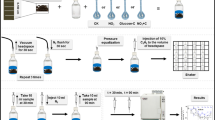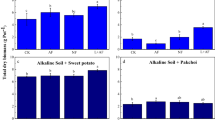Abstract
Low N use efficiency and high nitrate (NO -3 ) pollution potentials are problems in intensive vegetable production systems. The purpose of this study was to quantify N utilization by lettuce (Lactuca sativa L. cv Salinas), and identify periods of NO -3 loss in an on-farm study in the Salinas Valley in coastal California. During autumn and winter, surface moisture remained low, and NO -3 concentrations increased, reflecting high net mineralizable N, as determined by anaerobic incubation, and nitrification potential, as determined by the chlorate inhibition method. At the onset of a large winter storm, tracer levels of15NO -3 were injected in the top 5 mm of soil in 30 cm-deep cylinders. After two weeks, most of the15N was present as15NO -3 at 10–30 cm depth. By difference, losses to denitrification accounted for ~ 25% of the surface-applied15N. Leaching below 30 cm did not occur, since no15N enrichment of NO -3 -N was measured in anion-exchange resin membranes placed at the base of each cylinder. During the crop period, NO -3 losses were most pronounced after irrigation events. Uptake of N by two crops of lettuce (above- and belowground material) was approximately equal to fertilizer inputs, yet simulation of N fates by the Erosion/Productivity Impact Calculator (EPIC) model indicated losses of 14.6 g-N m−2 by leaching and 2.5 g-N m−2 by denitrification during the 6-month crop period. The large NO -3 losses can be attributed to accumulation of soil NO -3 during winter that was leached or denitrified during the irrigated crop period.
Similar content being viewed by others
References
Addiscott TM, Whitmore AP and Powlson DS (1991) Farming, Fertilizers and the Nitrate Problem. CAB International, Ozon, United Kingdom
Belser LW and Mays EL (1980) The specific inhibition of nitrite oxidation by chlorate and its use in assessing nitrification in soils and sediments. Appl Environ Microbiol 33: 309–333
Brooks PD, Stark JM, McInteer BB and Preston T (1989) Diffusion method to prepare soil extracts for automated Nitrogen-15 analysis. Soil Sci Am J 53: 1707–1711
Burns IG ( 1991 ) Short- and long-term effects of a change in the spatial distribution of nitrate in the root zone on N uptake, growth and root development of young lettuce plants. Plant Cell Env 14: 21–33
Carlson RM (1978) Automated separation and conductimetric determination of ammonia and dissolved carbon dioxide. Anal Chem 50: 1528–1532
Carlson RM (1986) Continuous flow reduction of nitrate to ammonium with granular zinc. Anal Chem. 58: 1590–1591
Doerge TA, Roth RL and Gardner BR (1991) Nitrogen Fertilizer Management in Arizona. Univ. of Arizona, Tucson, AZ
Feigin A, Letey J and Jarrell WM (1982) Nitrogen utilization efficiency by drip irrigated celery receiving preplant or water applied N fertilizer. Agron J 74: 978–983
Follett RW and DS Schimel (1989) Effect of tillage practices on microbial biomass dynamics. Soil Sci Soc Am J 53: 1091–1096
Freund RJ, Littell RC and Spector PC (1986) SAS System for Linear Models.SAS Institute Inc, Cary, NC
Frota JNE and Tucker TC (1972) Temperature influence on ammonium and nitrate absorption by lettuce. Soil Sci Soc Am Proc 36: 97–100
Hauck RD (1982) Nitrogen—isotope-ratio analysis. In: Stevenson FJ, Bremner JM, Hauck RD and Keeney DR (eds) Nitrogen in Agricultural Soils, pp 605–649. American Society of Agronomy, Madison, WI
House GD, Stinner BR, Crossley DA and Odum EP (1984) Nitrogen cycling in conventional and no-tillage agroecosystems: analysis of pathways and processes. J Appl Ecol 21: 991–1012
Jackson LE and Bloom AJ (1990) Root distribution in relation to soil nitrogen availability in field-grown tomatoes. Plant Soil 128: 115–126
Jackson LE and Stivers LJ (1993) Root distribution of lettuce under commercial production: implications for crop uptake of nitrogen. Biol Agric Hortic 9: 273–293
Jackson LE, Wyland LJ and Stivers LJ (1993) Winter cover crops to minimize nitrate losses in intensive lettuce production. J Agric Sci 121: 55–62
Klute A (1986) Methods of Soil Analysis, Part 1. Physical and Mineralogical Methods. American Society of Agronomy, Madison, WI
Linn DM and Doran JW (1984) Effect of water-filled pore space on carbon dioxide and nitrous oxide production in tilled and nontilled soils. Soil Sci Soc Am J. 48: 1267–1272
Lorenz OA and Maynard DN (1988) Handbook for Vegetable Growers. J. Wiley and Sons, New York
Lund LJ (1979) Nitrate leaching and nitrogen balances for selected fields in the Santa Maria Valley. In: Pratt PF, Biggar JW and Broadbent, FE (eds) Nitrate Effluents from Irrigated Lands, Final Report NSF-RANN, pp 355–415. CA Riverside, Univ. of California.
Martinez J and Guiraud G (1990) A lysimeter study of the effects of a ryegrass catch crop, during a winter wheat/maize rotation, on nitrate leaching and on the following crop. J Soil Sci 41: 5–16
National Oceanographic and Atmospheric Administration (1989–90) Climatological Data for California. National Climatic Data Center, Asheville, NC
Page AL, Miller RH and Keeney DR (1982) Methods of Soil Analysis, Part 2. Chemical and Microbiological Properties. American Society of Agronomy, Madison, WI
Powlson DS (1988) Measuring and minimising losses of fertilizer nitrogen in arable agriculture. In: Jenkinson DS and Smith KA (eds) Nitrogen Efficiency in Agricultural Soils, pp 231–245. Elsevier Science Publishing Co, Barking, Essex, U.K.
Radke JK, Andrews RW, Janke RR and Peters SE (1988) Low-input cropping systems and efficiency of water and nitrogen use. In: Hargrove WL (ed) Cropping Strategies for Efficient Use of Water and Nitrogen, pp 193–218. Special Publication Number 51. American Society of Agronomy, Madison, WI
Rice CW and Tiedje JM (1989) Regulation of nitrate assimilation by ammonium in soils and isolated soil microorganisms. Soil Biol Biochem 21: 597–602.
Richard JG, Sundstrom FJ, Grimes JA, Geaghan JP and Etzel WW (1985) Predicted effect of temperature and N fertilization on crop response of four cultivars of head lettuce. Comm Soil Sci Plant Anal 16: 583–613
Ryden JC and Lund LJ (1980) Nature and extent of directly measured denitrification losses from some irrigated vegetable crop production units. Soil Sci Soc Am J 44: 505–511
Schenk M, Heins B and Steingrobe B (1991) The significance of root development of spinach and kohlrabi for N fertilization. Plant Soil 135: 197–203
Schulbach K (1988) Season long crop water use and irrigation efficiency evaluation. Univ. of Calif. Cooperative Extension, Salinas, CA
Schulbach K (1992) Sample costs to produce lettuce in Monterey County-1992. Univ. of Calif. Cooperative Extension, Salinas, CA
Sharpley AN and Williams JR (1990) EPIC-Erosion/Productivity Impact Calculator: 1. Model Documentation. USDA Tech. Bull. No. 1768. National Technical Information Service, Springfield, VA
Seligman NG and van Keulen H (1981) A simulation model of annual pasture production limited by rainfall and nitrogen. In: Frissel MJ and van Veen JA (eds) Simulation of Nitrogen Behaviour of Soil-Plant Systems, pp 192–221. CABO, Wageningen, The Netherlands
Warden BT, House BW, Jackson LE and Tanji KK (1992) Modeling the fate of nitrogen in the rootzone: management and research applications. Proc. California Chapter of Agronomy Society of America, Fresno, CA
Waring SA and Bremner JM (1964) Ammonium production in soil under waterlogged conditions as an index of nitrogen availability. Nature (London) 201: 951–952
Williams JR and Renard KG (1985) Assessments of soil erosion and crop productivity with process models (EPIC). In: Follett RF and Stewart BA (eds) Soil Erosion and Crop Productivity, pp 67–103. ASA-CSSA-SSSA, Madison, WI
Zink FW and Yamaguchi M (1962) Studies on the growth rate and nutrient absorption of head lettuce. Hilgardia 32: 471–500
Author information
Authors and Affiliations
Rights and permissions
About this article
Cite this article
Jackson, L.E., Stivers, L.J., Warden, B.T. et al. Crop nitrogen utilization and soil nitrate loss in a lettuce field. Fertilizer Research 37, 93–105 (1994). https://doi.org/10.1007/BF00748550
Received:
Accepted:
Issue Date:
DOI: https://doi.org/10.1007/BF00748550




